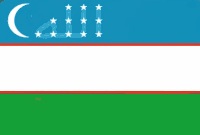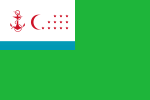Flag of Uzbekistan
The flag of Uzbekistan (Uzbek: Oʻzbekiston davlat bayrogʻi) consists of three horizontal blue, white and green bands separated by two thin red fimbriations, with a crescent moon and twelve stars at the canton. Adopted in 1991 to replace the flag of the Uzbek Soviet Socialist Republic (SSR), it has been the flag of the Republic of Uzbekistan since the country gained independence in that same year. The design of the present flag was partly inspired by the former one.
 | |
| Name | Oʻzbekiston davlat bayrogʻi |
|---|---|
| Use | Civil and state flag, civil and state ensign |
| Proportion | 1:2 |
| Adopted | 18 November 1991 |
| Design | A horizontal blue, white and green stripes, separated by two narrow red stripes. A crescent and three rows of twelve stars are situated on the left side of the upper blue stripe. |
.svg.png) Variant flag of Uzbekistan | |
| Use | War flag |
| Proportion | 1:2 |
| Adopted | 4 June 1992 |
| Design | A horizontal blue, white and green stripes, separated by two narrow red stripes. A crescent and three rows of twelve stars are situated on the left side of the upper blue stripe. On the white stripe are two lines of gold text that reads, "OʻZBEKISTON RESPUBLIKASI" (REPUBLIC OF UZBEKISTAN) and "QUROLLI KUCHLARI" (ARMED FORCES) |
Design
Symbolism
The symbolism of the National flag of the Republic of Uzbekistan continues the traditions inherent in the flags of major states and empires that existed in the country while reflecting the natural features of Uzbekistan, the national and cultural identity of the peoples of this Central Asian country.
The sky-blue color on the flag is a symbol of blue sky and clear water. Azure is revered in the East. Blue is also the color of the Turkic peoples. The majority of the population of Uzbekistan are Turkic peoples who speak Turkic languages.
White is a symbol of peace, purity, and kindness. White also means the ancient religion of Zoroastrianism, which was dominant in the territory of this country before the arrival of Islam.

Green is a symbol of the diverse and rich nature of the country. Green is also one of the colors of the Holy religion Islam, which is practiced by the majority of the population of Uzbekistan.
The red stripes are vital forces pulsating in every living creature, a symbol of life, courage, as well as a symbol of national and religious minorities of Uzbekistan.
The Crescent corresponds to the centuries-old tradition of the people of Uzbekistan and is also one of the main symbols of Islam. The Crescent moon and stars are also considered a symbol of a cloudless calm sky and peace.
The flag of Uzbekistan has 12 stars. The number 12 means 12 zodiac signs, 12 months of the year, and is also considered a symbol of perfection. In Islam, the number 12 is also important, as in 12 years according to Islam, boys become adults. 12 also means the 12 imams. 12 stars on the flag are arranged in such a way that visually they form the inscription Allah in Arabic script.[1][2][3][4]
Legal protection
On December 27, 2010, President Islam Karimov signed an amendment to the law that strengthened the protection of the country's symbols, including its flag and emblem. It banned the utilization of the flag of Uzbekistan for promotional and commercial purposes, including its usage in advertisements and documents. It also forbade any organizations that are not affiliated with the Uzbek government from adopting logos that resemble the national symbols.[5]
History
Under Soviet rule, the Union Republic – situated in what is now modern-day Uzbekistan – utilized a flag derived from the flag of the Soviet Union and representing Communism, that was approved in 1952.[1] The flag is similar to the Soviet design but with the blue stripe in 1/5 width and the two 1/100 white edges in between.
Uzbekistan declared itself independent on September 1, 1991, approximately three months before the dissolution of the Soviet Union.[4] A search for a national flag began soon after, with a contest being held to determine the new design.[1] More than 200 submissions were made, and a commission was formed in order to evaluate these suggestions coming from a variety of stakeholders.[6] The winning design was adopted on November 18, 1991,[1] after being selected at an extraordinary session of the Uzbek Supreme Soviet.[7][8] In doing so, Uzbekistan became the first of the newly independent republics in Central Asia to choose a new flag.[2] Pertaining to its tricolor combination of horizontal stripes of blue, white and green color, it is similar to the flags of Lesotho, an enclaved country within the border of South Africa, and Puntland, a Somali federal state at the tip of the Horn.[9]
Other flags
 Naval ensign of Uzbekistan
Naval ensign of Uzbekistan
References
- Smith, Whitney. "Uzbekistan, flag of". Encyclopædia Britannica. Encyclopædia Britannica, Inc. Retrieved May 18, 2014. (subscription required)
- Kindersley, Dorling (November 3, 2008). Complete Flags of the World. Dorling Kindersley Ltd. p. 191. Retrieved May 18, 2014.
- Waters, Bella (2006). Uzbekistan in Pictures. Twenty-First Century Books. p. 191. Retrieved May 18, 2014.
- "Uzbekistan". The World Factbook. CIA. Retrieved May 18, 2014.
- Azizov, D. (December 27, 2010). "Brief: Uzbekistan bans using state symbols in commercial purposes". Baku, Azerbaijan: Trend News Agency. Retrieved May 18, 2014. (subscription required)
- "The National Flag of the Republic of Uzbekistan Celebrates 20th Anniversary". Journal of Turkish Weekly. International Strategic Research Organization. November 18, 2011. Retrieved May 18, 2014.
- Azizov, D. (November 18, 2010). "Brief: Uzbekistan celebrates Flag Day". Baku, Azerbaijan: Trend News Agency. Retrieved May 18, 2014. (subscription required)
- McCray, Thomas R.; Gritzner, Charles F. (January 1, 2009). Uzbekistan. Infobase Publishing. p. 96. Retrieved May 18, 2014.
- Knowlton, Steven A. "Applying sebeok’s typology of signs to the study of flags." Raven: A Journal of Vexillology 19 (2012): 57-97.
External links
| Wikimedia Commons has media related to National flag of Uzbekistan. |
